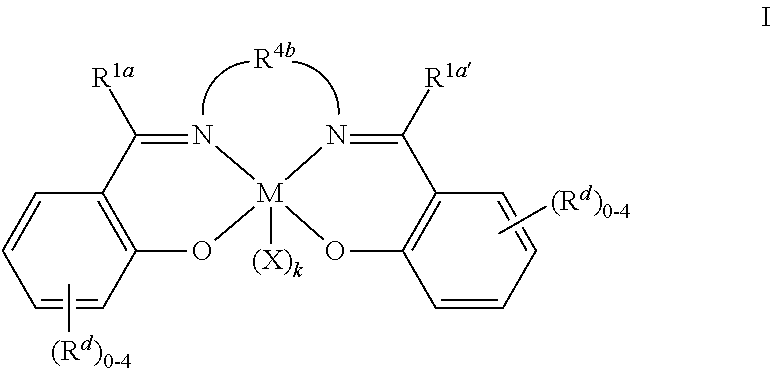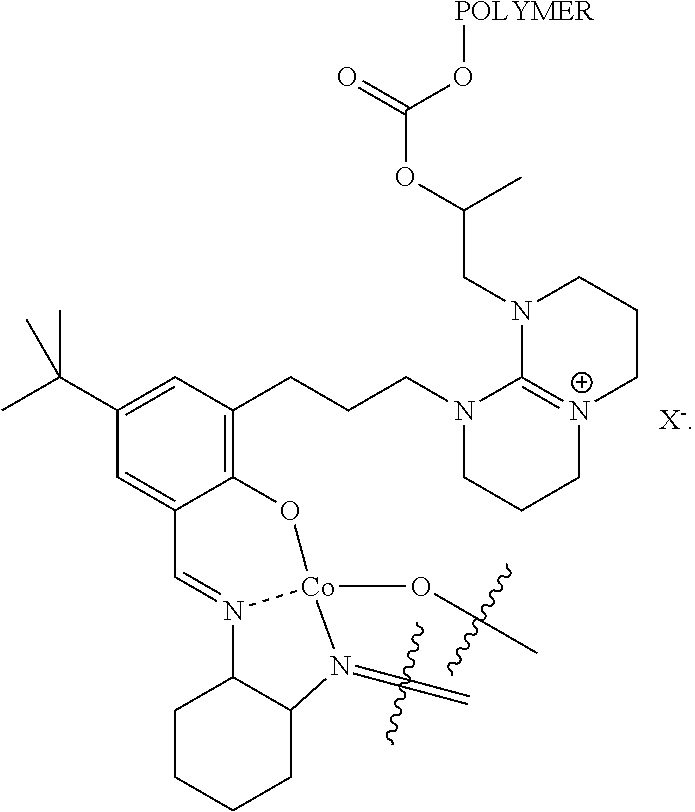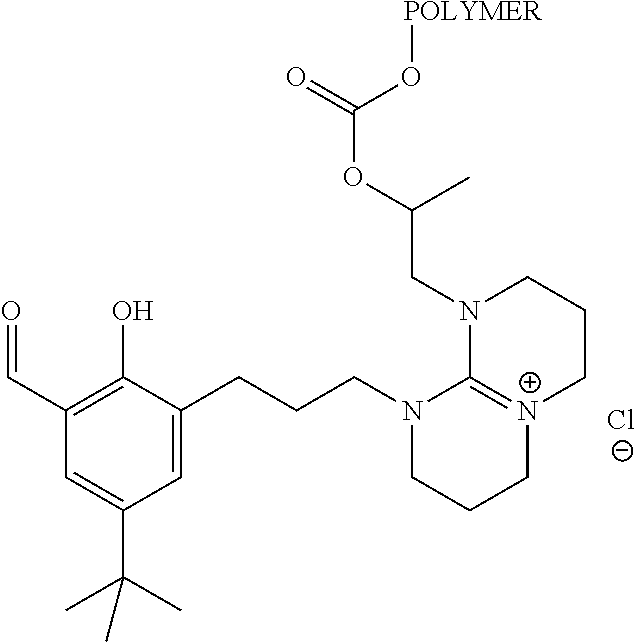Metal complexes
a technology of metal complexes and complexes, applied in the field of metal complexes, can solve problems such as the complicated separation of catalyst and polymer produ
- Summary
- Abstract
- Description
- Claims
- Application Information
AI Technical Summary
Benefits of technology
Problems solved by technology
Method used
Image
Examples
example 1
[0103]This example describes the synthesis of catalyst A.
[0104]A 10 wt % ethanolic solution of aldehyde 6 (6 is made according to Example 9 of WO 2012 / 040454, substituting 7-methyl-1,5,7-triazabicyclo[4.4.0]dec-5-ene with 1,8-diazabicyclo[5.4.0]undec-7-ene (DBU)), is contacted with an equimolar amount of the known ammonium salt 7 (described in Chemical Communications (2010), 46(17), 2935-2937) in the presence of NaOH to provide ligand 8. The ligand is treated with cobalt(II) acetate to afford the cobalt(II) complex and liberate two equivalents of acetic acid. This complex is oxidized in the presence of air to provide the desired catalyst.
example 2
[0105]This example describes the synthesis of additional catalysts of the present invention having alternate substitution patterns on the aryl rings of the salcy ligands. Compounds 2a through 2n are synthesized according to conditions of Example 1, except ammonium salts with alternate substitution patterns on the aryl ring are employed in place of the 2,4-di-t-butyl analog 7 used in Example 1. Compounds 2o through 2q are synthesized according to conditions of Example 1, except that 1,8-diazabicyclo[5.4.0]undec-7-ene is substituted with 1,5-diazabicyclo[4.3.0]non-5-ene. The required ammonium salts are obtained by condensing racemic trans 1,2 cyclohexanediamine monohydrochloride with salicaldehyde analogs having the desired substituents at the 2- and / or 4-positions. In each example, the catalyst is isolated as its carbonate salt, (i.e. X and Y are taken together to be CO32−).
example 3
[0106]This example describes the synthesis of catalysts of the present invention having alternate bridging groups between the imine nitrogen atoms of the salen ligands. Catalysts 3a and 3d through 3f are produced according to the method of Example 1, except the required ligand is made by sequential addition of the appropriate salicylaldehyde and aldehyde 6 to isobutylene diamine in the presence of 3-angstrom molecular sieves.
[0107]Catalysts 4b and 4c are produced according to the method of Example 1, by condensing aldehyde 6 with appropriate hydrochloride salts analogous to the 1,2 cyclohexane diamine-derived salt 7 used in Example 1. The required hydrochloride salts are produced in a separate step by sequential addition of one equivalent of HCl, and one equivalent of 2,4-di-tert butyl salicylaldehyde to ethylene diamine (3b) or 1,3 diaminopropane (3c).
PUM
| Property | Measurement | Unit |
|---|---|---|
| Composition | aaaaa | aaaaa |
| Structure | aaaaa | aaaaa |
Abstract
Description
Claims
Application Information
 Login to View More
Login to View More - R&D
- Intellectual Property
- Life Sciences
- Materials
- Tech Scout
- Unparalleled Data Quality
- Higher Quality Content
- 60% Fewer Hallucinations
Browse by: Latest US Patents, China's latest patents, Technical Efficacy Thesaurus, Application Domain, Technology Topic, Popular Technical Reports.
© 2025 PatSnap. All rights reserved.Legal|Privacy policy|Modern Slavery Act Transparency Statement|Sitemap|About US| Contact US: help@patsnap.com



